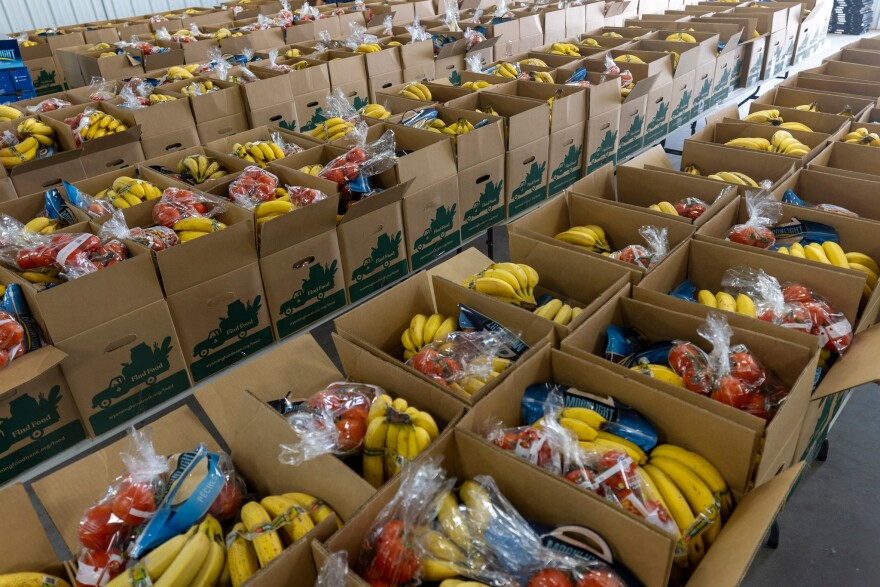Wyoming has distributed roughly $1.2 million to food pantries around the state through the state’s new Hunger Relief Program since Gov. Mark Gordon declared a public welfare emergency on Halloween.
The effort is a response to the ongoing back-and-forth about funding for federal SNAP benefits, formerly known as food stamps. Benefits did not go out to roughly 42 million Americans at the start of November because of the government shutdown. Roughly 28,000 Wyomingites accessed the program each month last fiscal year, with an average monthly payment of about $185 per person.
The Hunger Relief Program is working to fill in the gaps created by this lapse of federal funding. The Wyoming Department of Family Services (DFS) is administering the program and has distributed “$109,509 to independent pantries, $544,290 directly to food pantries who are affiliated with the Food Bank of Wyoming and $544,290 to the Food Bank of Wyoming,” according to a Monday press release from Gordon’s office.
Eva Estorga is the director of St. Joseph’s Food Pantry in Cheyenne, which has received additional funding from the Hunger Relief Program. She said the pantry typically sees 150 to 160 people each day, but that’s changed since the start of November.
“ Now it's 200, 210, 220. Monday was 230 and yesterday we were open,” she said. “Normally we would be closed because of the [Veteran’s Day] holiday, but we decided to open because of what's going on and just to be available for people.”
St. Joseph’s offers a box with non-perishable pasta, soups, and canned fruits and vegetables. Estorga said the additional state funding has helped the pantry add in more fresh foods, like eggs, milk and cheese.
“ We can sustain because of the help we're getting, because it's a tremendous strain money-wise and with volunteers … As we get into a bigger crunch, we need not just the money to buy the food, but volunteers to man the warehouse,” she said. “We’re doing it, it hasn't been cut down, but I am worried for the near future.”
Laramie County had the second-highest number of residents who accessed SNAP benefits this September at 4,860 people, according to Kelly Douglas at the Wyoming Department of Family Services. Natrona County had the most, with 5,003 recipients.
Debra Davis is the director of Joshua’s Storehouse, a food pantry in Casper. She’s also seen an increase in people coming to the location.
“We're getting busier. SNAP is affecting people that used to donate monetary or food items, and then they're coming back to the food pantries for help themselves,” she said.
Joshua’s Storehouse has used its Hunger Relief Program funds to purchase more food to stock its shelves.
“That has been a huge help to offset some of that stuff that we're not getting from our food partners,” said Davis. “We've been able to purchase more food from the Food Bank [of Wyoming].”
She added she hopes SNAP starts back up soon and that people can “start doing what they do and living and not having to choose between groceries and bills and going without.”
The U.S. House of Representatives is set to vote to end the shutdown as soon as Wednesday. If approved, the bill will go to President Trump for his signature. The proposed deal does not include any plan to extend enhanced healthcare premium subsidies, the Democrat’s central ask in the shutdown standoff.
The current bill draft would fund most of the government through January, but also contains a provision that would fund SNAP through next September.
That could bring some clarity to the SNAP funding rollercoaster.
Last week, the Trump administration agreed to partially fund SNAP and refuted judges’ orders to support the full cost of the program. The U.S. Supreme Court then temporarily blocked that order on the night of Nov. 7 in an effort to more fully consider the matter in a lower court. When and how partial SNAP benefits will reach people with this back-and-forth remains unclear.
On Nov. 8, the Trump administration also ordered states to “undo” any efforts to fully fund SNAP. Wyoming’s Hunger Relief program doesn’t fund the federal program directly, and the statewide food relief is open to all, not just those enrolled in SNAP.
In a Monday press release, Gordon said “Wyoming will continue to help those in need. No one in Wyoming wants their neighbors to go hungry.”
Gordon’s office said it will keep releasing money each week until the shutdown ends, and the relief will end once the federal government is running again.








